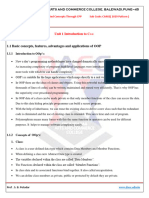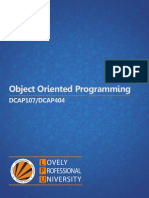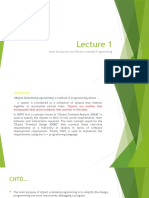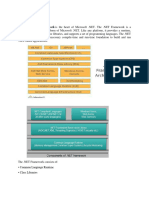0 ratings0% found this document useful (0 votes)
11 viewsOOP Introduction Arduino C++
Uploaded by
Ramkumar ACopyright
© © All Rights Reserved
We take content rights seriously. If you suspect this is your content, claim it here.
Available Formats
Download as PPTX, PDF, TXT or read online on Scribd
0 ratings0% found this document useful (0 votes)
11 viewsOOP Introduction Arduino C++
Uploaded by
Ramkumar ACopyright
© © All Rights Reserved
We take content rights seriously. If you suspect this is your content, claim it here.
Available Formats
Download as PPTX, PDF, TXT or read online on Scribd
You are on page 1/ 11
Introduction to Object-Oriented
Programming (OOP) in Arduino
C++
Understanding the Basics and
Application in Embedded Systems
What is OOP?
• Object-Oriented Programming (OOP) is a
programming paradigm that uses objects and
classes to structure and organize code.
• Key Concepts: Encapsulation, Inheritance,
Polymorphism, and Abstraction.
• Relevance to Arduino: OOP allows for better
code organization and reuse, which is crucial
in embedded systems where managing
complexity is key.
Why OOP in Arduino?
• • Code Reusability: Create modular and
reusable code.
• • Data Management: Encapsulate data within
objects, making it easier to manage.
• • Scalability: Easier to scale and maintain large
projects.
• • Real-World Modeling: Simulate real-world
systems more effectively.
Basic OOP Concepts
• • Class: A blueprint for creating objects.
Defines a datatype by bundling data and
methods that work on the data.
• • Object: An instance of a class. Represents
real-world entities.
• • Encapsulation: Hiding internal data and
exposing only necessary parts.
• • Inheritance: Deriving new classes from
existing ones.
• • Polymorphism: Methods that can do
Classes and Objects in Arduino
• Class Structure in C++:
– class MyClass {
• public:
• int myAttribute; // Attribute
• void myMethod() { // Method
– // Code here
•}
– };
– Creating Objects:
• MyClass myObject;
• Example: A class representing an LED with
Encapsulation in Arduino
• Encapsulation: Keep data (attributes) safe
from outside interference and misuse.
• Access Specifiers:
– • Public: Accessible from anywhere.
– • Private: Accessible only within the class.
– • Protected: Accessible within the class and
derived classes.
• Example:
– class LED {
• private:
Inheritance in Arduino
• Inheritance: A class can inherit attributes and
methods from another class.
• Base Class: The class being inherited from.
• Derived Class: The class that inherits.
• Example:
– class ButtonLED : public LED {
• public:
• ButtonLED(int p) : LED(p) {}
• void blink() {
– turnOn();
– delay(500);
Polymorphism in Arduino
• Polymorphism: A function can take many
forms. Allows for methods to behave
differently based on the object.
• Function Overriding: A derived class can
provide a specific implementation of a method
already defined in its base class.
• Example:
– class LED {
• public:
• virtual void blink() {
Practical Application: LED Control
Using OOP
• Objective: Demonstrate how to use classes
and objects to control LEDs in an Arduino
project.
• Steps:
– 1. Define an LED class.
– 2. Create multiple LED objects.
– 3. Use methods to control each LED
independently.
• Code Example:
• LED led1(8);
Conclusion
• Recap of Key Points:
• • OOP organizes code using classes and
objects.
• • Encapsulation, Inheritance, and
Polymorphism are core OOP principles.
• • OOP in Arduino leads to more modular,
maintainable, and scalable code.
• Next Steps:
– • Implement small projects using OOP concepts in
Arduino.
Q&A
• • Invite Questions: Encourage questions to
clarify any concepts or applications discussed.
• • Contact Information: Provide your email or
other contact information for follow-up
questions.
You might also like
- Notes CA403 Object Oriented Programming Using C SybbacaNo ratings yetNotes CA403 Object Oriented Programming Using C Sybbaca49 pages
- Object Oriented Programming: What Is OOP?No ratings yetObject Oriented Programming: What Is OOP?14 pages
- Object Oriented Programming With C - Ug1No ratings yetObject Oriented Programming With C - Ug192 pages
- Blue Modern Abstract Presentation 20250329 092950 0000No ratings yetBlue Modern Abstract Presentation 20250329 092950 00008 pages
- Introduction To Object Oriented Programming: UNIT-1No ratings yetIntroduction To Object Oriented Programming: UNIT-130 pages
- Object Oriented Programming Concepts in C++ - StudytonightNo ratings yetObject Oriented Programming Concepts in C++ - Studytonight6 pages
- Dcap107 Dcap404 Object Oriented Programming PDFNo ratings yetDcap107 Dcap404 Object Oriented Programming PDF329 pages
- Updated Lecture Notes On Object Oriented Programming-1No ratings yetUpdated Lecture Notes On Object Oriented Programming-119 pages
- 5-Features of OOP, Differences between structured and object-oriented PrograNo ratings yet5-Features of OOP, Differences between structured and object-oriented Progra93 pages
- Rayalaseema University, Kurnool: Paper-IV: Programming in C and C++ Programming in C: Unit - INo ratings yetRayalaseema University, Kurnool: Paper-IV: Programming in C and C++ Programming in C: Unit - I76 pages
- CS 214 Object Oriented Programming: Department of Computer Science and EngineeringNo ratings yetCS 214 Object Oriented Programming: Department of Computer Science and Engineering95 pages
- Object Oriented Programming Using C Plus PlusNo ratings yetObject Oriented Programming Using C Plus Plus223 pages
- Object-Oriented Programming (OOP) in DartNo ratings yetObject-Oriented Programming (OOP) in Dart6 pages
- Data Structures and Object Oriented ProgrammingNo ratings yetData Structures and Object Oriented Programming10 pages
- Object-Oriented-Programming-Using-C-Characteristics-of-Object-Oriented-Programming-2No ratings yetObject-Oriented-Programming-Using-C-Characteristics-of-Object-Oriented-Programming-211 pages
- Machine Learning with Python: A Comprehensive Guide with a Practical ExampleFrom EverandMachine Learning with Python: A Comprehensive Guide with a Practical ExampleNo ratings yet
- Graded Engineering Laboratory Experiment PDFNo ratings yetGraded Engineering Laboratory Experiment PDF7 pages
- U14MCT701 Industrial Automation Ii L T P C 3 0 0 3No ratings yetU14MCT701 Industrial Automation Ii L T P C 3 0 0 32 pages
- Engineering Rubrics For Presentation Skills Technical ContentNo ratings yetEngineering Rubrics For Presentation Skills Technical Content2 pages
- SoMachine Introduction - Compatibility and Migration - enNo ratings yetSoMachine Introduction - Compatibility and Migration - en152 pages
- The Products and The Processes .: Tamil Nadu Precision Farming ProjectNo ratings yetThe Products and The Processes .: Tamil Nadu Precision Farming Project50 pages
- MiCloud Flex Security Operations Guidelines V1.0No ratings yetMiCloud Flex Security Operations Guidelines V1.037 pages
- Object Oriented Programming Lab Mca Department, Krupanidhi Group of InstitutionsNo ratings yetObject Oriented Programming Lab Mca Department, Krupanidhi Group of Institutions27 pages
- To Simulate Analog and Digital Function Blocks: Aim: ObjectiveNo ratings yetTo Simulate Analog and Digital Function Blocks: Aim: Objective7 pages
- How To Perform A Recovery With Initialization On Maxdb/LivecacheNo ratings yetHow To Perform A Recovery With Initialization On Maxdb/Livecache18 pages
- Subkey: The Client's Choice For An Encryption Key To Be Used To Protect This SpecificNo ratings yetSubkey: The Client's Choice For An Encryption Key To Be Used To Protect This Specific11 pages
- Lenovo Smart Clock Essential: Safety, Warranty & Quick Start GuideNo ratings yetLenovo Smart Clock Essential: Safety, Warranty & Quick Start Guide31 pages
- Final Exam Information: 1) Prepare and Test Your SetupNo ratings yetFinal Exam Information: 1) Prepare and Test Your Setup3 pages
- Java Programming: From Problem Analysis To Program DesignNo ratings yetJava Programming: From Problem Analysis To Program Design75 pages
- Netflix User and Movies Interest Analysis For Asian CountriesNo ratings yetNetflix User and Movies Interest Analysis For Asian Countries5 pages
- Company Setup: 1. How To Create A New CompanyNo ratings yetCompany Setup: 1. How To Create A New Company93 pages
- HoduCC - MT - Agent - User - Manual - V 3.5.1No ratings yetHoduCC - MT - Agent - User - Manual - V 3.5.1114 pages
- Notes On Programming in Excel (Typescript Included)No ratings yetNotes On Programming in Excel (Typescript Included)16 pages











































































































